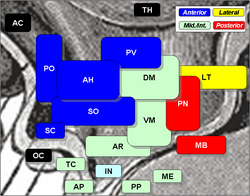| Lateral hypothalamus | |
|---|---|
 Lateral hypothalamus is 'LT', at right, in yellow. | |
| Identifiers | |
| MeSH | D007026 |
| NeuroNames | 426 |
| NeuroLex ID | birnlex_4037 |
| TA98 | A14.1.08.929 |
| FMA | 62030 |
| Anatomical terms of neuroanatomy | |
The lateral hypothalamus (LH), also called the lateral hypothalamic area (LHA),[1] contains the primary orexinergic nucleus within the hypothalamus that widely projects throughout the nervous system;[2] this system of neurons mediates an array of cognitive and physical processes, such as promoting feeding behavior and arousal, reducing pain perception, and regulating body temperature, digestive functions, and blood pressure, among many others.[2][3][4] Clinically significant disorders that involve dysfunctions of the orexinergic projection system include narcolepsy, motility disorders or functional gastrointestinal disorders involving visceral hypersensitivity (e.g., irritable bowel syndrome),[3][5] and eating disorders.[6]
The neurotransmitter glutamate and the endocannabinoids (e.g., anandamide) and the orexin neuropeptides orexin-A and orexin-B are the primary signaling neurochemicals in orexin neurons;[3][4][7] pathway-specific neurochemicals include GABA, melanin-concentrating hormone, nociceptin, glucose, the dynorphin peptides, and the appetite-regulating peptide hormones leptin and ghrelin, among others.[3][8] Notably, cannabinoid receptor 1 (CB1) is colocalized on orexinergic projection neurons in the lateral hypothalamus and many output structures,[4][7] where the CB1 and orexin receptor 1 (OX1) receptors form the CB1–OX1 receptor heterodimer.[4][9][10]
- ^ hier-409 at NeuroNames
- ^ a b Cite error: The named reference
NHM Orexinwas invoked but never defined (see the help page). - ^ a b c d Cite error: The named reference
Orexin functions reviewwas invoked but never defined (see the help page). - ^ a b c d Flores A, Maldonado R, Berrendero F (December 2013). "Cannabinoid-hypocretin cross-talk in the central nervous system: what we know so far". Frontiers in Neuroscience. 7: 256. doi:10.3389/fnins.2013.00256. PMC 3868890. PMID 24391536.
Direct CB1-HcrtR1 interaction was first proposed in 2003 (Hilairet et al., 2003). Indeed, a 100-fold increase in the potency of hypocretin-1 to activate the ERK signaling was observed when CB1 and HcrtR1 were co-expressed ... In this study, a higher potency of hypocretin-1 to regulate CB1-HcrtR1 heteromer compared with the HcrtR1-HcrtR1 homomer was reported (Ward et al., 2011b). These data provide unambiguous identification of CB1-HcrtR1 heteromerization, which has a substantial functional impact. ... The existence of a cross-talk between the hypocretinergic and endocannabinoid systems is strongly supported by their partially overlapping anatomical distribution and common role in several physiological and pathological processes. However, little is known about the mechanisms underlying this interaction.
• Figure 1: Schematic of brain CB1 expression and orexinergic neurons expressing OX1 or OX2
• Figure 2: Synaptic signaling mechanisms in cannabinoid and orexin systems
• Figure 3: Schematic of brain pathways involved in food intake - ^ Cite error: The named reference
Orexin synapses onto vagus nerve – visceral hypersensitivitywas invoked but never defined (see the help page). - ^ Cite error: The named reference
Orexin-A CNS thermowas invoked but never defined (see the help page). - ^ a b Watkins BA, Kim J (2014). "The endocannabinoid system: directing eating behavior and macronutrient metabolism". Frontiers in Psychology. 5: 1506. doi:10.3389/fpsyg.2014.01506. PMC 4285050. PMID 25610411.
CB1 is present in neurons of the enteric nervous system and in sensory terminals of vagal and spinal neurons in the gastrointestinal tract (Massa et al., 2005). Activation of CB1 is shown to modulate nutrient processing, such as gastric secretion, gastric emptying, and intestinal motility. ... CB1 is shown to co-localize with the food intake inhibiting neuropeptide, corticotrophin-releasing hormone, in the paraventricular nucleus of the hypothalamus, and with the two orexigenic peptides, melanin-concentrating hormone in the lateral hypothalamus and with pre-pro-orexin in the ventromedial hypothalamus (Inui, 1999; Horvath, 2003). CB1 knockout (KO) mice showed higher levels of CRH mRNA, suggesting that hypothalamic EC receptors are involved in energy balance and may be able to mediate food intake (Cota et al., 2003). ... The ECS works through many anorexigenic and orexigenic pathways where ghrelin, leptin, adiponectin, endogenous opioids, and corticotropin-releasing hormones are involved (Viveros et al., 2008).
- ^ Cite error: The named reference
Detailed output book refwas invoked but never defined (see the help page). - ^ Thompson MD, Xhaard H, Sakurai T, Rainero I, Kukkonen JP (2014). "OX1 and OX2 orexin/hypocretin receptor pharmacogenetics". Frontiers in Neuroscience. 8: 57. doi:10.3389/fnins.2014.00057. PMC 4018553. PMID 24834023.
OX1–CB1 dimerization was suggested to strongly potentiate orexin receptor signaling, but a likely explanation for the signal potentiation is, instead, offered by the ability of OX1 receptor signaling to produce 2-arachidonoyl glycerol, a CB1 receptor ligand, and a subsequent co-signaling of the receptors (Haj-Dahmane and Shen, 2005; Turunen et al., 2012; Jäntti et al., 2013). However, this does not preclude dimerization.
- ^ Jäntti MH, Mandrika I, Kukkonen JP (March 2014). "Human orexin/hypocretin receptors form constitutive homo- and heteromeric complexes with each other and with human CB1 cannabinoid receptors". Biochemical and Biophysical Research Communications. 445 (2): 486–90. doi:10.1016/j.bbrc.2014.02.026. PMID 24530395.
Orexin receptor subtypes readily formed homo- and hetero(di)mers, as suggested by significant BRET signals. CB1 receptors formed homodimers, and they also heterodimerized with both orexin receptors. ... In conclusion, orexin receptors have a significant propensity to make homo- and heterodi-/oligomeric complexes. However, it is unclear whether this affects their signaling. As orexin receptors efficiently signal via endocannabinoid production to CB1 receptors, dimerization could be an effective way of forming signal complexes with optimal cannabinoid concentrations available for cannabinoid receptors.